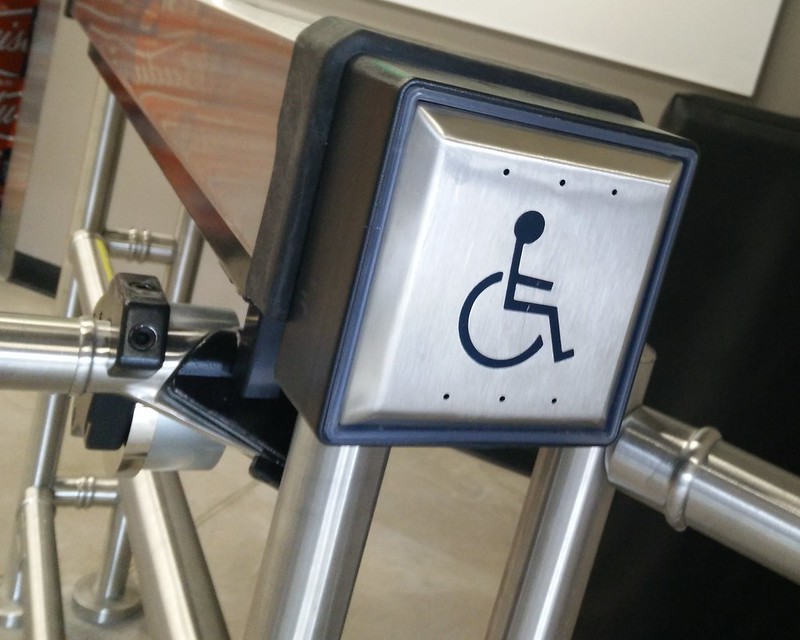
If you want a lesson in how government can change things, take a walk or, if you’re in a wheelchair, a roll. As you do, you may notice that most pedestrian crosswalks have inclines to help people in wheelchairs move from street to sidewalk (as well as parents with strollers and people dragging wheeled suitcases).
Approach a new or renovated building and you may notice that, in addition to steps leading to the door, it has a ramp. This, again, is for people with wheelchairs or others having difficulty walking, but these ramps are also a huge help for delivery people. Go to the rear of the building and you may find parking spaces for the handicapped.
Inside, you’ll probably notice elevators with wide doors and buttons at waist level, restrooms with wide stalls and handrails, and sinks pitched a little lower than the ones in your house. If the building has a snack bar, you may see that the service counter is lower than in older buildings. If there’s a TV over the counter, the volume may be low but you can read the closed captions.
These small accommodations and hundreds like them exist today mostly because of the Americans with Disabilities Act, which passed Congress and was signed into law by President George H.W. Bush in 1990. Probably no law before or since has made so many changes in America’s built environment and done so in ways so subtle as to be unnoticed by most.
But that’s only half of the ADA’s significance. It also changed how we welcomed people with disabilities into our schools and colleges and places of work and entertainment. This is one reason that the New York Times called the ADA “the most sweeping anti-discrimination measure since the Civil Rights Act of 1964.”
How did the Americans with Disabilities Act come about? Much as the Civil Rights Act did, through a combination of persistent activism; a rising tide of public opinion; and enough political will to get an ambitious law through both houses of Congress and the president’s signature.
The activism unfolded over four decades, from the early 1960s through the implementation of the ADA. There were many pioneers but one was Ed Roberts, a polio survivor and quadriplegic who fought to win admission to the University of California at Berkeley in 1962 and stayed to teach there, where he became a leader in the disability-rights movement and won a MacArthur genius grant. Brad Lomax was another leader. A member of the Black Panthers who was adept at organizing protests, he brought those skills to the disability-rights movement as multiple sclerosis robbed him of mobility. He was a leader of one of the most memorable demonstrations of the 1970s, as disabled protesters occupied a federal office in San Francisco.
The activism made disabled people more visible and their desires for equal participation better known. But they needed a set of laws that actually reduced barriers. And here’s where the Civil Rights Act of 1964 became important, not only as a model of how sweeping new laws are passed but for its legal precedents.
The Civil Rights Act went beyond requiring that governments provide equal rights to requiring that businesses do so as well. (The Supreme Court ruled that this was permitted under the federal government’s power to regulate interstate commerce.) This was an important precedent.
The drafters of the Americans with Disabilities Act drew on other laws. One was the Rehabilitation Act of 1973, which protected people with disabilities from job discrimination by federal contractors and grant recipients. Obviously, this limited the act’s impact, but the Rehab Act had introduced two concepts that would be critical to the ADA. First was a definition of disability. Second was the notion of accommodation—altering a job in a sensible way so that a person with a disability could perform it.
These ideas were adopted in the ADA with little change but then extended to all private businesses. This is why, from offices to grocery stores, movie theaters to restaurants, you can find elevators with instructions in Braille, wide aisles, and restrooms that accommodate wheelchairs. And not just accommodate the disabled as customers; like the Civil Rights Act, the ADA required that private companies not discriminate against people with disabilities in hiring or promotions.
The ADA’s impact took decades to be felt, as local building codes changed and offices and stores were built or remodeled. And it had a major impact on public education as special education—aimed at serving children with physical or mental disabilities—quietly remade how schools operated.
What have been the benefits? For the nearly 19 percent of Americans with disabilities, they’ve been immeasurable. It means 56.7 million people saw barriers to work, travel, or life’s other daily pleasures reduced. Today, 20 percent of working-age people with severe disabilities and 55 percent with moderate disabilities are employed year round. (This compares to 61 percent of working-age people without disabilities.)
And if you are not one of the disabled? The efforts to reduce barriers have probably helped you as well, as you may realize next time you walk into a building with wheeled luggage. Still not convinced? Give it time, as 71 percent of those age 80 or older have some form of disability that is made more tolerable by automated doors or accessible elevators. For these small acts of fairness and convenience, we can thank government.
More information:
https://en.wikipedia.org/wiki/Americans_with_Disabilities_Act_of_1990
https://www.ada.gov/ada_intro.htm
Give the credit to: federal government
Photo by Mike Gifford licensed under Creative Commons.
Leave a Reply